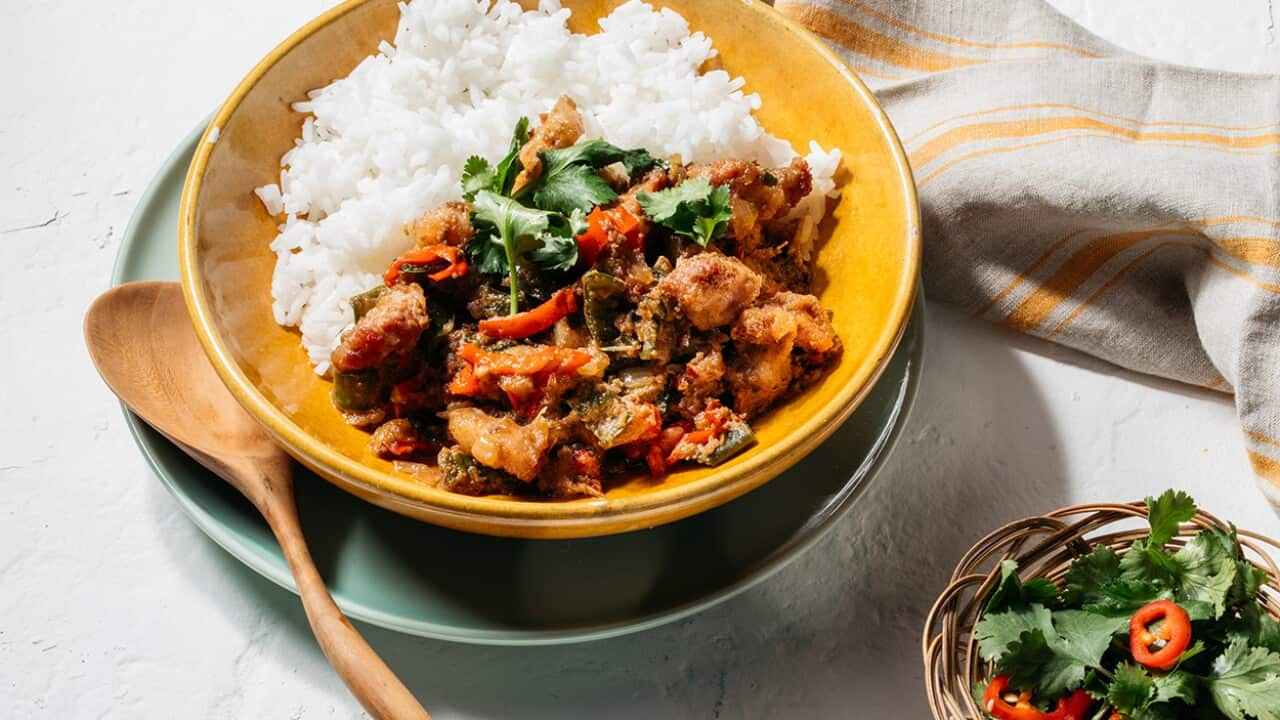--- Join Yasmin Newman as she explores a range of Filipino dishes and flavours in streaming now at ---
The tomato, or kamatis as it's known in the Philippines, is woven throughout Filipino cuisine. It forms one-third of the sauteed holy trinity known as guisado, the Filipino equivalent to sofrito. It's the star of the show in countless saucy ulam (braises) and fiesta fare, and sours quintessential native dishes, from sawsawan (dipping sauces) to sinigang (sour soup).
KEY INGREDIENTS

Opening the door on my Filipino pantry
Yet, tomatoes are not native to the Philippines. As some may know, the fruit originated in South America, first as a wild species in the Andes ranges and later a crop in what is now considered Mexico (its name comes from the Náhuatl (Aztec) word tomatl). Following the arrival of the Spanish to the Americas in the early 16th century, tomatoes made their way to Europe. And the rest is history. Well, for Europe's love affair with the tomato at least.
In 1521, explorer Ferdinand Magellan landed on a string of islands and claimed what would later be renamed the Philippines under the Spanish crown. Far from home, the new Spanish settlement demanded familiar flavours, from ham, chorizo and cheese to chickpeas, capsicum and saffron. Over the three-and-a-half centuries of colonial rule, both the ingredients and dishes of the conquistadors were absorbed into the local cuisine. Some were adapted to local palates, like longganisa, a sweet and garlicky (and may I say utterly addictive) spin-off of chorizo. Others were completely remade with local ingredients, such as bringhe, a relative of paella made with sticky rice, coconut milk and turmeric (although a more traditional form also exists called paella valenciana).  Another class of dishes more closely retained their Spanish DNA. As I wrote in my first book, 7,000 Islands: "To the native Filipino, Spanish fare was luxurious. Frying and stewing produced rich results compared to traditional grilling and steaming. Meat was also a rare commodity in a diet of rice, vegetables and seafood, and expensive imported ingredients were priced way beyond locals' means. Foremost, it was a symbol of class and power."
Another class of dishes more closely retained their Spanish DNA. As I wrote in my first book, 7,000 Islands: "To the native Filipino, Spanish fare was luxurious. Frying and stewing produced rich results compared to traditional grilling and steaming. Meat was also a rare commodity in a diet of rice, vegetables and seafood, and expensive imported ingredients were priced way beyond locals' means. Foremost, it was a symbol of class and power."

Source: Kitti Gould
TOMATO STEWS

Which Filipino tomato-based stews are which?
These dishes eventually became 'fiesta fare', food for special occasions warranting extravagance. From relleno to embutido, you can hear the Spanish lineage in the names. Among the best-known fiesta dishes are the tomato-based braises: afritada, menudo, mechado, kaldereta, which today have been absorbed into everyday dishes and renamed in local regions and local tongue, like kinamatisang manok.
However, language can sometimes cloak the origin of dishes and ingredients (like Chinese congee, renamed in Spanish and still called arroz caldo to this day). And in the case of the tomato, the widely unknown ties between Mexico and the Philippines.
The Spanish armada arrived in Mexico just two years before the Philippines, and not long after both countries had become unwitting children to new dictatorial parents. Far from the hegemony in Europe, Mexico became the administrative department for Latin America, as well as the far-flung Asian Isles.
And so began The Galleon Trade between Manila in the Philippines and Acapulco in Mexico, and an enduring connection. Another excerpt from 7,000 Islands: "While the Philippines profited from tomatoes, potatoes, cassava, peanuts, capsicum, pineapple, papaya, cacao and avocado, amongst others, Mexico enjoyed mangoes, tamarind, rice and tuba (coconut toddy). Native Mexican dishes also made their way into Filipino mouths. Chocolate porridge tsamporado is a close cousin to the Mexican drink champurrado, as are tamales in both countries."
During a year's university exchange in Mexico, I was staggered by its similarities to the Philippines. Even locals considered my look Latina. I took it for the colonial connection – nothing more. With research, I learnt of centuries of contact and close ties. Sadly, few Filipinos know the Mexican riches hidden under a Spanish guise. Ancient words for crops, such as sincama or singkamas (jicama), chayote or sayote (choko) and achuete (annatto seeds), highlight Latin American roots, but language masks the rest.
Colonial rule connected two countries on opposite sides of the Pacific. The galleon ships have long sailed, but the link endures. It is etched into words and preserved in food.
Filipino tomatoes are slightly sour and firm, with a mottled green and red skin versus the sweet tomato we're more familiar with here - a function of the tropic environment and tastes.
The story of the tomato doesn't stop here (catsup is another thrilling sequel). But it's a fascinating account of how one ingredient can tell so much of the history of a country and influence the breadth of a cuisine.
MORE FILIPINO FOOD

A Filipino chicken soup brimming with chewy glass noodles








